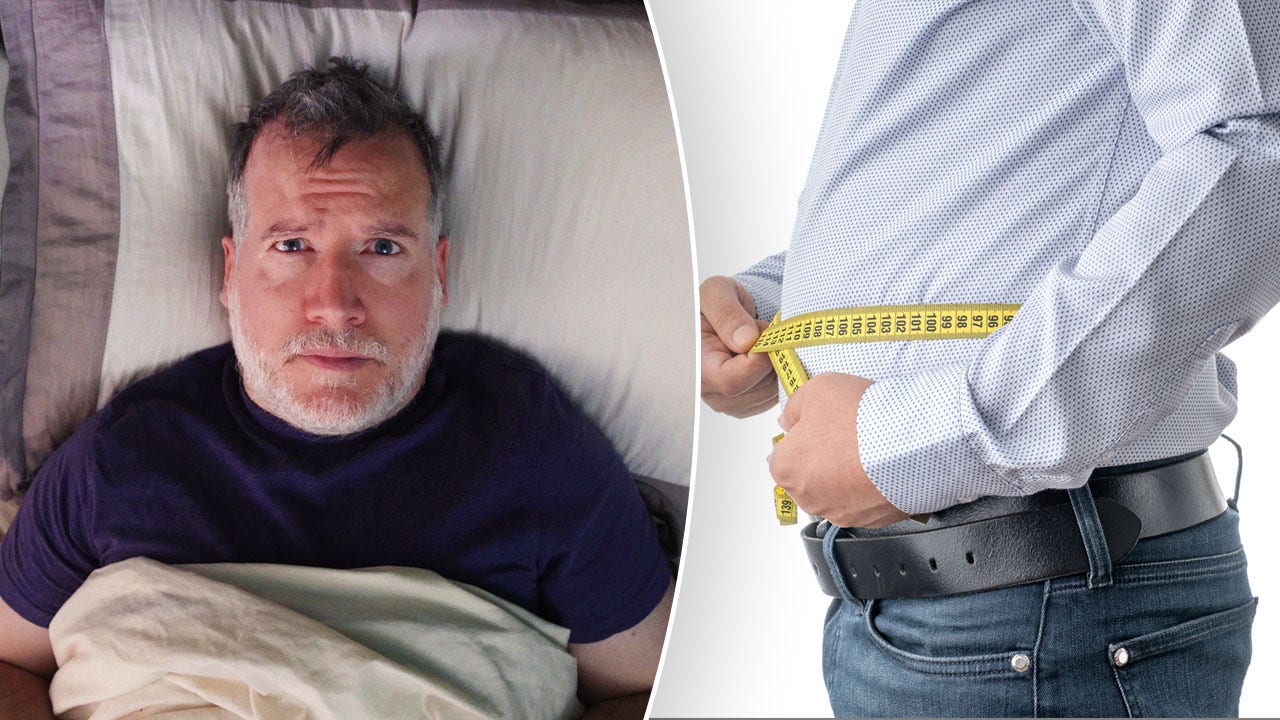Health
Lack of sleep could be a factor in a 'silent epidemic,' experts warn

More than a third of adults fail to get the recommended seven to eight hours of sleep each night — and the scarcity of shuteye can have a surprising effect.
Lack of sleep can lead to what some experts refer to as a “silent epidemic” — a condition called non-alcoholic fatty liver disease (NAFLD), which affects more than one in four American adults, according to the American Heart Association.
What is non-alcoholic fatty liver disease (NAFLD)?
As its name implies, NAFLD is marked by the presence of fat in the liver.
SLEEP DISORDERS AND SUICIDE: A MENTAL HEALTH EXPERT REVEALS THE CONCERNING LINK
The primary cause is weight gain, along with metabolic risk factors such as type 2 diabetes, high blood pressure, high triglycerides and obstructive sleep apnea, according to Ibrahim Hanouneh, a gastroenterologist with MNGI Digestive Health in Minnesota.
Lack of sleep can lead to what some experts refer to as a “silent epidemic” — a condition called non-alcoholic fatty liver disease (NAFLD), which affects more than one in four American adults. (iStock)
“Heavy alcohol consumption can also lead to fatty liver, but NAFL refers to fatty liver that occurs in the setting of metabolic syndrome and weight gain in the absence of heavy alcohol consumption — hence the name ‘non-alcoholic,’” Hanouneh told Fox News Digital.
The condition is also known as MASLD (metabolic dysfunction associated steatotic liver disease) to reflect the association between fatty liver and metabolic syndrome.
IMPROVE YOUR SLEEP BY OPTIMIZING 6 BIOMARKERS: ‘INTEGRAL TO HEALTH’
A family history of fatty liver can also increase the risk, noted Hanouneh, who is also co-author of the book “Regenerative Health: Discover Your Metabolic Type and Renew Your Liver for Life.”
NAFL is known as the “silent epidemic” because it often has no symptoms.
“In some studies, fatty liver has affected 25% to 33% of the general population — almost one out of four individuals — but the vast majority of individuals have no symptoms at all, particularly in the early stages,” said Hanouneh.

The primary cause of NAFLD is weight gain, along with metabolic risk factors such as type 2 diabetes, high blood pressure, high triglycerides and obstructive sleep apnea. (iStock)
Some people may have non-specific symptoms, such as fatigue, foggy memory and abdominal pain.
“Generally speaking, fatty liver disease does not cause major symptoms until it is too late — for example, when the patient has already developed cirrhosis or liver cancer,” Hanouneh said.
Fatty liver disease is associated with an increased risk of liver cirrhosis and liver cancer.
“The vast majority of individuals have no symptoms at all, particularly in the early stages.”
“NAFLD has become the leading indication of liver transplantation and the leading cause of liver cancer in the Western world,” noted Hanouneh.
Patients with this disease are also at an increased risk of cardiovascular events, such as heart attacks and strokes, he warned.
“Some studies also suggest that patients with NAFL are at an increased risk of getting type 2 diabetes,” he added.

Patients with this disease are also at an increased risk of cardiovascular events, such as heart attacks and strokes, a doctor warned. (iStock)
Not all people with NAFLD experience liver damage. Nonalcoholic steatohepatitis (NASH), the more severe form, leads to swelling or inflammation of the liver and damage to liver cells, according to the American Liver Foundation’s website.
This can ultimately lead to fibrosis, or scarring, of the liver.
Link between sleep and NAFLD
Lack of high-quality sleep has been linked to weight gain, an increase in hunger and adverse blood sugar control in multiple studies, according to Kristin Kirkpatrick, a registered dietitian at Cleveland Clinic and co-author of “Regenerative Health.”
“Insulin resistance is a major risk factor for abnormal amounts of fat in the liver,” said Kirkpatrick.
PITTSBURGH BOY, 10, NEEDS SECOND LIVER TRANSPLANT TO SAVE HIS LIFE: ‘ONLY POSSIBLE THROUGH LOVE’
The risk is particularly high for postmenopausal women, she noted. One study found that chronic short sleep duration led to a 20% increase in insulin levels among that group, compared to 15% overall.
“The stress on the body caused by a lack of sleep can cause adverse metabolic changes that ultimately may lead to NAFLD,” Kirkpatrick said.

Lack of high-quality sleep has been linked to weight gain, an increase in hunger and adverse blood sugar control, studies have shown. (iStock)
The expert also cited a new study in JAMA (the Journal of the American Medical Association) showing that short sleep duration increased the risk for type 2 diabetes.
“Though some risks could be offset by a healthy diet, a majority could not be reversed by a nutrient-rich dietary pattern,” she said.
ALWAYS FEELING TIRED? EXPERTS SHARE 4 COMMON CAUSES OF DAYTIME FATIGUE
“Type 2 diabetics have a significant increase in risk of developing NAFLD.”
Maintaining consistent sleeping hours may help with weight management, Kirkpatrick told Fox News Digital.
“That means going to bed and waking up at the same time on weekdays and weekends.”
Screening, treatment and prevention
Due to the “silent” nature of NAFLD, experts stressed the importance of screening for fatty liver in patients with risk factors — even if there are no signs or symptoms of liver disease.
“NAFLD is a preventable disease,” Hanouneh told Fox News Digital.
“It is also a reversible disease at early stages.”

Imaging tests, such as ultrasounds or CT scans, can visually assess the appearance of the liver. (iStock)
Three main types of tests are used to diagnose the condition, according to JAMA Network.
Blood tests can measure inflammation in the liver.
Imaging tests, such as ultrasounds or CT scans, can visually assess the appearance of the organ.
“NAFLD is a preventable disease — and reversible at early stages.”
There are also some newer tests that measure the amount of fat in the liver — “such as transient elastography, an ultrasound-based test that measures how stiff the liver is” — but they may not be very reliable for diagnosing more advanced liver disease, JAMA Network stated.
For those who have been diagnosed, a low-carbohydrate diet is key to managing fatty liver disease, experts agreed.
CLICK HERE TO SIGN UP FOR OUR HEALTH NEWSLETTER
“Studies suggest that a low-carb diet that leads to weight loss of 5% to 10% can potentially reverse fatty liver disease,” Hanouneh said.
“Also, cut back or abstain from alcohol depending on the degree of fatty liver disease.”

It’s important to follow up with a health care professional to manage metabolic risk factors, doctors advised. (iStock)
It’s also important to follow up with a health care professional to manage metabolic risk factors, he said — particularly type 2 diabetes, which is “crucial in the management of fatty liver disease.”
For people with NAFLD, Hanouneh also recommended incorporating regular exercise, particularly interval training, three times a week.
Coffee has also shown potential benefits for fatty liver.
“I typically recommend one to two cups of black coffee a day if possible,” Hanouneh said.
For more Health articles, visit foxnews.com/health

Health
Celebrity Weight Loss Transformations: See Their Before and After Photos!

Sign Up
Create a free account to access exclusive content, play games, solve puzzles, test your pop-culture knowledge and receive special offers.
Already have an account? Login
Use left and right arrow keys to navigate between menu items.
Use escape to exit the menu.
Health
BMI is wrong way to measure obesity, researchers say — here’s what they recommend instead

A group of 58 researchers is calling for a new, better way to measure obesity.
The global team’s recommendations were published in The Lancet Diabetes & Endocrinology on Jan. 14.
Body mass index (BMI) has been the international standard for measuring obesity since the 1980s, according to many sources, though some experts have questioned its validity.
OZEMPIC ‘MICRODOSING’ IS THE NEW WEIGHT-LOSS TREND: SHOULD YOU TRY IT?
A person’s BMI is calculated by dividing his or her weight by the square of his or her height in feet.
Body mass index (BMI) has been the international standard for measuring obesity since the 1980s, according to many sources, though some experts have questioned its validity. (iStock)
“Obesity is a complex problem and has different significance at the individual level,” the report’s lead author Francesco Rubino, chair of bariatric and metabolic surgery at King’s College London, United Kingdom, told Fox News Digital.
Obesity is a “spectrum,” he said, rather than a “single, distinct clinical entity.”
Rubino went on, “It is impossible to say if obesity is a disease or not, as disease status cannot coincide with body size or mere excess body fat.”
DR. NICOLE SAPHIER ON ULTRA-PROCESSED FOODS IN AMERICA: ‘PEOPLE PROFIT OFF ADDICTION’
The Commission on Clinical Obesity has proposed a “reframing” of obesity that distinguishes between people who have a disease here and now, and those who may have a risk for future disease, Rubino said.
Instead of relying solely on BMI, the researchers recommend also measuring adiposity, which is the amount of excess body fat.

A person’s BMI is calculated by dividing his or her weight by the square of his or her height in feet. (iStock)
Adiposity can be determined by measuring a person’s waist circumference or taking body scans to measure fat mass, according to the researchers.
The group of experts recommends using two levels of obesity: preclinical and clinical.
With preclinical obesity, the person has excess body fat that has not affected the function of their tissues and organs.
“People with clinical obesity suffer from a chronic illness and should be treated in the same way as people who suffer from any other chronic disease.”
The person may have, however, an increased risk of developing clinical obesity, type 2 diabetes, heart disease and some types of cancer, the researchers noted.
Clinical obesity is defined as “a chronic, systemic illness characterized by alterations in the function of tissues, organs, the entire individual or a combination thereof, due to excess adiposity.”
DIABETES AND WEIGHT LOSS DRUGS SHOWN TO REDUCE ALCOHOL-RELATED HOSPITALIZATIONS, STUDY FINDS
With clinical obesity, the person may experience “severe end-organ damage, causing life-altering and potentially life-threatening complications,” the researchers wrote.
Potential effects of clinical obesity may include heart attack, stroke and kidney failure.
“As these categories of obesity are entirely new, we can’t measure their relative prevalence in the population,” Rubino noted. “Doctors have not yet had the possibility to make such a diagnosis, because many of the organ dysfunctions that characterize clinical obesity have not been routinely assessed so far.”

When excess body fat is confirmed, clinicians should assess individuals to determine whether obesity may have caused any organ dysfunction, the study researcher said. (iStock)
The researchers call for future studies into these diagnoses.
“We recommend that clinicians thoroughly assess people with obesity in the clinic and use other measures of body size — waist circumference or others — to understand if an increased BMI level is due to excess body fat or other reasons, like increased muscle mass,” Rubino told Fox News Digital.
‘HIDDEN’ FAT COULD PREDICT ALZHEIMER’S DISEASE UP TO 20 YEARS BEFORE SYMPTOMS, RESEARCH FINDS
When excess body fat — meaning obesity — is confirmed, clinicians should assess individuals to determine whether obesity may have caused any organ dysfunction, the researcher said.
“People with clinical obesity suffer from a chronic illness and should be treated in the same way as people who suffer from any other chronic disease,” Rubino said.
People with preclinical obesity should undergo “evidence-based health counseling, monitoring of their health status over time, and, when applicable, appropriate intervention to reduce risk of developing clinical obesity,” they wrote.
Between August 2021 and August 2023, approximately 40% of U.S. adults had obesity, according to the Centers for Disease Control and Prevention (CDC). Around 9.4% of those adults had severe obesity.
‘Outdated measure’
Dr. Brett Osborn, a neurosurgeon, longevity expert and fitness competitor based in Florida, agrees that BMI is an “outdated measure” for diagnosing obesity.
“It is clear that obesity should no longer be defined solely by physical appearance or weight.”
“As medicine evolves, it is clear that obesity should no longer be defined solely by physical appearance or weight — or weight relative to height, as in BMI calculations,” the doctor, who was not involved in this new research, told Fox News Digital.
“Instead, the condition must be understood through the lens of metabolic dysfunction.”
Obesity isn’t just a disease of excess weight, Osborn said, but a “systemic metabolic disorder requiring nuanced and individualized care.”
The condition is better measured by looking at factors like inflammation, insulin resistance and glucose tolerance, according to the doctor.
CLICK HERE TO SIGN UP FOR OUR HEALTH NEWSLETTER
In some cases, using BMI can result in “muscular athletes” being labeled as obese, he noted, and people with “normal” BMI can sometimes have “harmful” levels of visceral (abdominal) fat.
Osborn noted that in his own clinic, he and his team do not use BMI, relying instead on visceral fat scores, skeletal muscle mass and body fat percentage.

In some cases, using BMI can result in “muscular athletes” being labeled as obese, one doctor noted. (iStock)
Skeletal muscle mass (the muscles that connect to the bones) is critical to physical strength and metabolic efficiency, Osborn said.
For optimal health, he recommends that males aim for 50% skeletal muscle mass relative to total body weight and females target 45% — although other factors, like age and fitness levels, come into play.
For more Health articles, visit www.foxnews.com/health
“Remember, your resilience — your ability to ward off disease — resides in your muscle,” Osborn added.
“By integrating body composition metrics, metabolic markers and personalized assessments, we can more accurately diagnose obesity and tailor interventions to each individual.”
Health
Water for Weight Loss? How Much You Should Drink to Shed More Weight

Sign Up
Create a free account to access exclusive content, play games, solve puzzles, test your pop-culture knowledge and receive special offers.
Already have an account? Login
Use left and right arrow keys to navigate between menu items.
Use escape to exit the menu.
-

 Science1 week ago
Science1 week agoMetro will offer free rides in L.A. through Sunday due to fires
-
/cdn.vox-cdn.com/uploads/chorus_asset/file/23935558/acastro_STK103__01.jpg)
/cdn.vox-cdn.com/uploads/chorus_asset/file/23935558/acastro_STK103__01.jpg) Technology1 week ago
Technology1 week agoAmazon Prime will shut down its clothing try-on program
-
/cdn.vox-cdn.com/uploads/chorus_asset/file/25826211/lorealcellbioprint.jpg)
/cdn.vox-cdn.com/uploads/chorus_asset/file/25826211/lorealcellbioprint.jpg) Technology1 week ago
Technology1 week agoL’Oréal’s new skincare gadget told me I should try retinol
-
/cdn.vox-cdn.com/uploads/chorus_asset/file/25832751/2192581677.jpg)
/cdn.vox-cdn.com/uploads/chorus_asset/file/25832751/2192581677.jpg) Technology5 days ago
Technology5 days agoSuper Bowl LIX will stream for free on Tubi
-

 Business7 days ago
Business7 days agoWhy TikTok Users Are Downloading ‘Red Note,’ the Chinese App
-
/cdn.vox-cdn.com/uploads/chorus_asset/file/25835602/Switch_DonkeyKongCountryReturnsHD_scrn_19.png)
/cdn.vox-cdn.com/uploads/chorus_asset/file/25835602/Switch_DonkeyKongCountryReturnsHD_scrn_19.png) Technology3 days ago
Technology3 days agoNintendo omits original Donkey Kong Country Returns team from the remaster’s credits
-

 Culture3 days ago
Culture3 days agoAmerican men can’t win Olympic cross-country skiing medals — or can they?
-
/cdn.vox-cdn.com/uploads/chorus_asset/file/24774110/STK156_Instagram_threads_1.jpg)
/cdn.vox-cdn.com/uploads/chorus_asset/file/24774110/STK156_Instagram_threads_1.jpg) Technology1 week ago
Technology1 week agoMeta is already working on Community Notes for Threads















